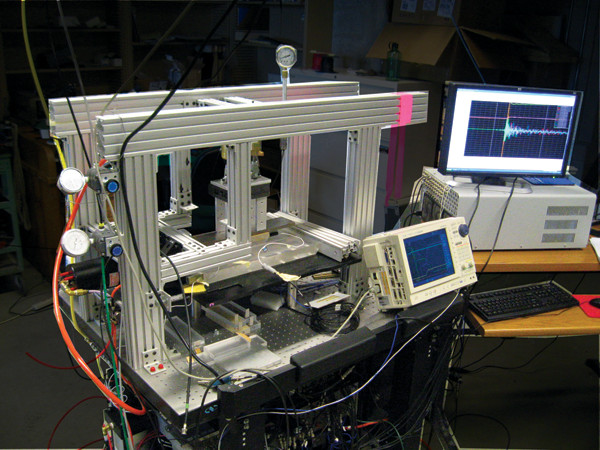
by Timothy Oleson Tuesday, February 12, 2013

This tabletop model consisting of adjacent Plexiglas slabs is used to simulate earthquakes and study fault healing. Gregory McLaskey
Much like our voices create sound waves with a variety of low and high pitches, or frequencies, earthquakes also produce seismic waves over a spectrum of frequencies. The seismic waves’ frequencies determine, in part, how far they travel and how damaging they are to human-made structures. But teasing out the details of how quake-generating faults influence seismic frequencies is no easy task, mainly because faults tend to be buried deep underground. Now, with the help of a tabletop earthquake model, researchers have identified how a process known as fault healing can shape seismic waves.
Fault healing, which can occur on all types of faults, is akin to a wound healing on your skin, says Gregory McLaskey, a geophysicist and post-doctoral fellow at the U.S. Geological Survey in Menlo Park, Calif. It’s well understood that “if a fault sits for a long time … it gets a little bit stronger,” says McLaskey, lead author of a new study in Nature comparing fault healing in laboratory experiments with field observations. “The two sides of a fault are essentially welding together” through physical and chemical processes that smooth out rough spots and increase the contact area between the sides, he says.
To study fault healing in the lab, McLaskey and his colleagues built a tabletop earthquake model consisting of two Plexiglas slabs, representing the blocks of rock on either side of a fault. The blocks were held together by a compressive perpendicular force — a stand-in for the pressure deep in Earth’s crust that keeps faults from sliding freely. As the amount of shear force pushing one slab laterally past the other was increased or decreased, the researchers monitored the frequencies of the model-generated seismic waves resulting from each “rupture” — when the friction holding the slabs in place was overcome and one slipped a small distance over the other — as well as the length of time between each instance of slip. No matter how much the researchers varied the perpendicular compression or the roughness of the slab faces, the basic outcome was the same: The low-frequency waves emitted were consistent, but the portion of high-frequency waves grew as the time between slip events increased.
Earthquake-induced seismic wave frequencies span several orders of magnitude, from about 0.001 hertz up to several hundred hertz. Low-frequency waves can travel long distances but usually do not cause much damage, whereas the highest-frequency waves tend to dissipate in the ground very close to the earthquake source. But relatively high-frequency waves of up to several tens of hertz can still travel over long distances, posing a potential danger to buildings and bridges, many of which are most vulnerable to damage by seismic waves between about 1 and 10 hertz, McLaskey says.
McLaskey’s team also examined a real-world analog to their laboratory experiments, repeating earthquake sequences — small batches of quakes that recur regularly on the same portion of a fault — on the San Andreas Fault near Parkfield, Calif., before and after the nearby magnitude-6 event in 2004. The earthquake loaded stress on the neighboring fault sections “much faster than normal,” McLaskey says. This caused “these little earthquake sequences to start firing off much more frequently than normal,” about once a day or once a week, he says, before they eventually slowed down again to the background rate of once every year or two.
McLaskey and his colleagues then compared how the length of time between quakes on the fault affected the resulting seismic frequencies, which were measured by the dense array of seismometers already in place around Parkfield. “It’s a much more subtle effect” compared to the tabletop measurements, McLaskey says, but the results showed “a similar trend.”
The specific mechanism that produces the high-frequency waves remains unknown. But in general, “when something is very welded together, it’s going to break more sharply, more abruptly,” McLaskey says, “And it’s that sharpness and the abruptness that are causing the high frequencies.”
The study provides “an important observation that gives us insight into fault mechanics and the processes governing the evolution of fault strength,” says Eric Dunham, a geophysicist at Stanford University who was not involved with the study. “Very little is known about the healing processes of natural faults due to the inaccessibility of fault zones,” Dunham says, so comparisons like this study are “a step in the right direction.”
“The remaining open question,” Dunham says, is whether “larger earthquakes also vary in time in a predictable way.” He says answering this will likely take a long time because repeat intervals for such quakes are very long.
McLaskey and his colleagues noted that it’s not just time that promotes fault healing: Higher pressures and temperatures, the presence and volume of fluids, and perhaps even certain types of minerals may help the process along as well. The combination of these contributions means that a given fault may heal at variable rates depending on depth or location. This might explain why, particularly in large earthquakes like the 2011 magnitude-9 Tohoku quake in Japan, the highest-frequency seismic waves do not necessarily emanate from where the largest amount of slip occurred. “This is kind of throwing a wrench into some of our ideas in earthquake science,” McLaskey says.
© 2008-2021. All rights reserved. Any copying, redistribution or retransmission of any of the contents of this service without the expressed written permission of the American Geosciences Institute is expressly prohibited. Click here for all copyright requests.